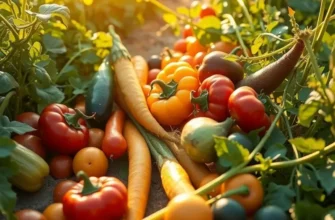Cooking healthy meals doesn’t have to be complicated or daunting. Embracing simple cooking methods can pave the way to nutritious eating without sacrificing flavor or enjoyment. Understanding how to prepare meals using fresh ingredients will empower your health journey, inspire creativity, and ultimately lead to better food choices. Whether you’re a novice to nutrition or someone looking to enhance their dietary habits, this guide will introduce you to accessible, wholesome cooking techniques that fit seamlessly into your routine.
Embracing the Power of Steaming

Steaming vegetables stands as a beacon of health in the realm of cooking, retaining essential nutrients that often vanish during other cooking methods. When vegetables are boiled, vital vitamins such as C and B often leach into the water, reducing their nutritional impact. Steaming gently cooks vegetables while keeping their nutritional profiles largely intact.
Let’s delve into a variety of vegetables and see how steaming can take center stage in your kitchen. Broccoli, for instance, when steamed, preserves its sulforaphane content—a compound linked to cancer-fighting properties. This green marvel only needs about 5 minutes in the steamer for optimal texture and nutrition retention, making it a quick addition to any meal.
Carrots, another colorful favorite, benefit significantly from steaming. Unlike broccoli, carrots tend to release more antioxidants when cooked. Steaming carrots for around 8-10 minutes softens them just enough to unlock their full potential without sacrificing flavor or nutrients.
Leafy greens like spinach and kale are nutrition powerhouses. However, they shrink dramatically when exposed to heat. Steaming these greens enhances their calcium content by breaking down oxalates—a compound that typically hinders absorption. Aim for a light steam of 2-3 minutes to tenderize these greens while maintaining their vibrant color and rich nutrients.
Cruciferous vegetables such as cauliflower take on a unique sweetness and maintain their anti-cancer compounds when lightly steamed. A mere 5-6 minute steam helps maintain a firm texture without becoming mushy, perfect for pairing with a flavorful sauce.
Integrating steaming into your culinary routine doesn’t require elaborate setups. A simple bamboo basket or a metal steaming rack within a lidded pot will suffice. For multi-tasking, a multi-tiered electric steamer can steam different vegetables simultaneously, maximizing your cooking efficiency.
Curious about adding more flavor without additional salt? Herbs and aromatics such as fresh thyme, garlic slivers, or lemon wedges can be placed directly on steamed vegetables to infuse subtle flavors as they cook. For more tips on flavor enhancement, explore our guide to flavor boosters without salt.
Steaming is not limited to vegetables; you can branch out with proteins like fish or tofu. Both become irresistibly tender and retain their moisture, enhancing their natural flavors. The versatility of steaming even allows it to complement any meal style you adopt, whether plant-based, high-protein, or low-carb.
With its minimal prep and clean-up, steaming aligns perfectly with lifestyle shifts towards sustainable and mindful eating. So, dust off that forgotten steamer and embrace this wholesome cooking method that promises flavor, nutrition, and simplicity in every bite.
Sautéing: Quick and Flavorful

Sautéing is an essential cooking technique, perfect for those who want to maximize flavor with minimal effort. Unlike boiling or steaming, sautéing uses a small amount of fat, such as oils, which acts as a conduit to transfer heat directly into the food, resulting in enhanced flavors and textures.
To start, selecting the right oil is crucial. Oils with high smoke points, like avocado or grapeseed oil, are ideal for sautéing, as they can withstand higher temperatures without burning. Olive oil, with its lower smoke point, is better suited for medium heat sautéing, imparting a distinctive flavor perfect for vegetables and softer proteins like fish. For a healthier twist, use oils that provide additional nutritional benefits, such as flaxseed oil, which is rich in omega-3 fatty acids. However, be mindful of its lower heat tolerance.
When it comes to foods, a vast array can be sautéed to perfection. Vegetables like bell peppers, onions, and zucchini caramelize beautifully. Their natural sugars develop complex flavors, making them a delightful addition to any dish. For proteins, think chicken, shrimp, or tofu; they cook quickly, retaining their moisture while basking in the sautéed seasoning.
To keep the experience quick and healthy, follow a few simple steps. Begin with preheated oil in a non-stick pan to prevent sticking—this reduces the need for additional fat. Cut food into uniform, bite-sized pieces to ensure even cooking. Overcrowding the pan is a common mistake that steams rather than sautés, so allow each piece of food room to sear properly.
Sautéing is not just about speed; it’s about coaxing out flavor. Infuse your oil with garlic, ginger, or a sprig of rosemary for a burst of aroma and taste. Add these aromatics at the beginning of cooking to allow them the time to release their full essence. For those looking to enhance flavor without additional salt, consider exploring flavor boosters that complement sautéed dishes beautifully.
To make sautéing even more efficient, mise en place is your ally. Mise en place—French for “everything in its place”—involves preparing and arranging ingredients before cooking. This ensures a smooth flow and minimizes the rush, allowing you to focus entirely on crafting the dish.
Remember, the goal is to keep it fresh, nutritious, and delightful. Sautéing opens a world of culinary exploration for beginners and seasoned cooks alike, providing a foundation for both simple weekday meals and more elaborate culinary endeavors. Let your imagination guide you as you experiment with herbs, spices, and the vibrant colors of fresh produce. There’s always more to uncover in the art of sautéing.
Final words
Adopting simple cooking methods like steaming and sautéing can dramatically impact your health without overwhelming your routine. By choosing these techniques, you can enjoy fresh, flavorful meals that supply essential nutrients. Start experimenting with different vegetables and proteins to create tasty combinations that satisfy your palate. As you continue to expand your culinary skills with easy methods, you’ll gain confidence in your ability to nourish yourself and those around you. Remember, cooking well is not just a task; it’s a fulfilling journey towards a healthier lifestyle.







